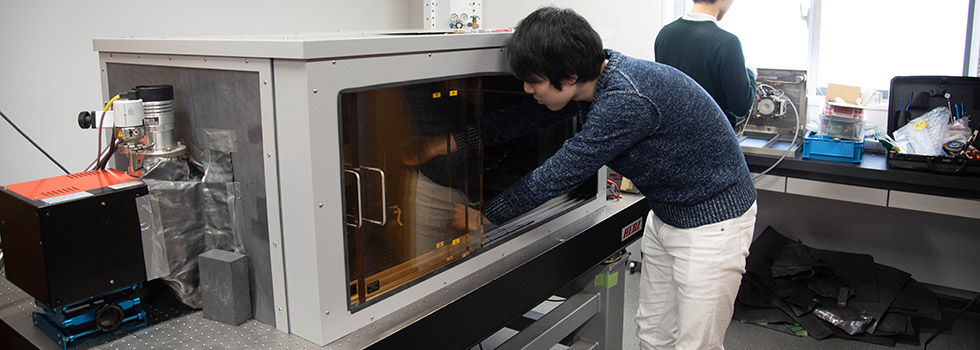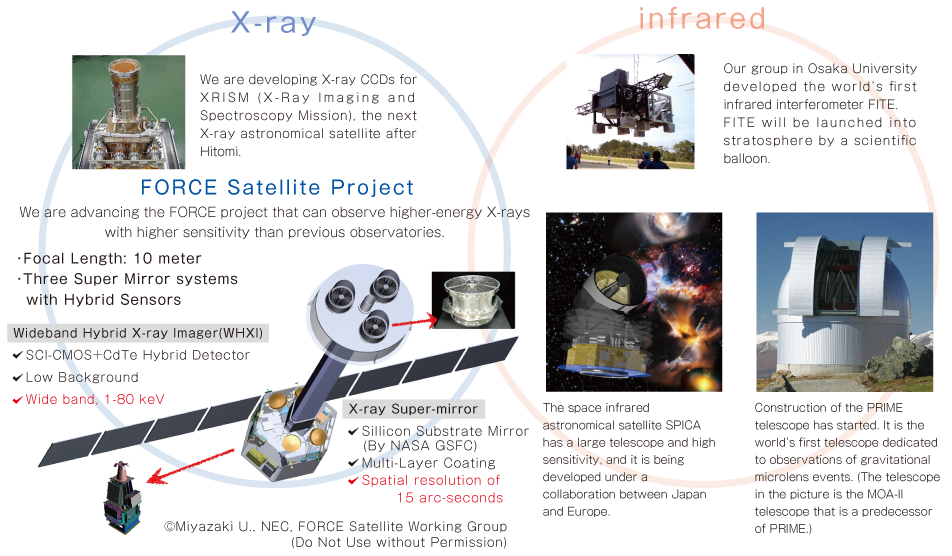
Investigating the formation of the universe, the physics of black holes and other extreme heavenly bodies, and searching for exoplanets and space-life phenomena
Research in these fields is performed in order to investigate the formation of the universe and the physics of black holes and other extreme heavenly bodies, to search for exoplanets, and the phenomena of space life. X-rays and infrared are important electromagnetic wave ranges for observational astrophysics. In developing the systems for fine and high-sensitivity observation of the universe, we apply all available cutting-edge technology. We aim at conducting observations ourselves with our own instruments. In particular, we are working on development and construction of the X-ray camera of the X-Ray Imaging and Spectroscopy Mission (XRISM) satellite that will be launched in near future as a successor to the Hitomi satellite and the FITE far-infrared interferometer telescope that will be mounted on scientific observation balloons.
FEATURE
We are engaged in the development and construction of key telescopes and systems for space research and perform analysis and research on observational data obtained using these systems. Our focus is on X-rays and infrared rays, and we apply unique methods to meet the challenges of cutting-edge research.
RESULTS

Research progress
X-ray camera of our development and construction mounted on the Hitomi X-ray astronomical satellite and on the MAXI all-sky survey system of the International Space Station
The X-ray camera systems we developed and constructed for the Hitomi X-ray astronomical satellite and the Monitor of All-sky X-ray Image (MAXI) mission of the International Space Station yielded key observational results on the elucidation of hot gas in galaxy clusters governed by dark matter. The life of the Hitomi satellite was short, but the next X-ray astronomical satellite that will be launched in the early 2020s will also carry our camera. We have also completed the development and construction of our far-infrared interferometer on board a scientific balloon, which will be launched from an overseas base. The system will be the first in the world to increase far infrared resolution by using the interferometer technique.
Further development
Promoting future X-ray and infrared observational projects with international collaborations
We are now working jointly with other domestic organizations and the NASA Goddard Space Flight Center to advance the Focusing On Relativistic universe and Cosmic Evolution (FORCE) program for the observation of high-energy X-rays with high angular resolution. One of the main objectives of the FORCE program is to elucidate the source of cosmic X-ray background radiation, which contribute to a better understanding of the growth of giant black holes. In the Space Infrared Telescope for Cosmology and Astrophysics (SPICA) program of Japan, Europe, America, and Asian countries, and in the American-led Wide Field Infrared Survey Telescope (WFIRST) program, we are playing a leading role in coordination with other Japanese researchers. These efforts promise to provide new insights into the processes of galaxy, star, and planetary-system formation following the birth of the universe during the Big Bang.